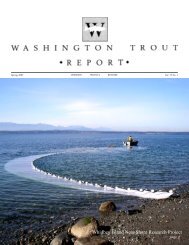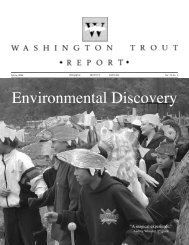Seafood Watch
Pacific Salmon - Wild Fish Conservancy
Pacific Salmon - Wild Fish Conservancy
- No tags were found...
You also want an ePaper? Increase the reach of your titles
YUMPU automatically turns print PDFs into web optimized ePapers that Google loves.
<strong>Seafood</strong> <strong>Watch</strong>® Wild Pacific Salmon Report October 8, 2010<br />
Overall, pink salmon landings in Alaska indicate the stock is in good health. Despite record<br />
landings, the main concern revolves around the long-term effects of hatchery supplementation,<br />
particularly in Prince William Sound. As Figure 2.6 indicates, returns of wild pink salmon in<br />
Prince William Sound have fallen over the past twenty years, while returns of hatchery pink<br />
salmon have increased. This disparity has led at least one set of analysts to conclude that Prince<br />
William Sound pink salmon hatcheries are replacing rather than augmenting wild pink salmon<br />
production in the region, with the likely causes of replacement being “a decline in wild<br />
escapement associated with harvesting hatchery stocks and biological impacts of the hatchery<br />
fish on wild fish” (Hilborn and Eggers 2000). A more recent summary of research has suggested<br />
that wild pink salmon decreases in the Sound have been primarily caused by biophysical<br />
variables (Heard 2003). The authors note that pink salmon hatcheries in the Prince William<br />
Sound create a net gain of pink salmon up to 25 million fish, though “under certain worst-case<br />
scenarios there might be up to a 4.5 million annual wild stock yield loss due to hatchery releases”<br />
(Heard 2003). In summary, hatchery operations in Prince William Sound appear to be depressing<br />
escapement of wild pink salmon, though the significance of this decrease (e.g., relative to direct<br />
fishery impacts on other stocks) remains unclear. Despite the decline, projected wild pink salmon<br />
escapement in Prince William Sound in 2004 is 4.6 million fish, above the sustainable<br />
escapement goal range of 1.3-2.8 million fish (Plotnick and Eggers 2004).<br />
Figure 2.6. Returns and survival of hatchery and wild pink salmon in Prince William<br />
Sound (Willette et al. 2001).<br />
45






